Environmental Measures Disrupt Transmission of HAIs
Time, staff, and budget constraints make it difficult to expand HAI mitigation programs despite the obvious and urgent need to do so.
(Adobe Stock)

Health care–acquired infections (HAIs), also called nosocomial infections, are 1 of the top 10 leading causes of death in the United States.1 HAIs cost hospitals billions of dollars each year, which reduces profitability. Historically, HAIs were considered an acceptable risk of hospitalization until evidence proved that most were preventable.2
In the past decade, governments began holding hospitals accountable for preventable HAIs. Although most states passed laws requiring hospitals to report infections, many failed to do so.3 The Leapfrog Group, a health care safety organization, recently released Hospital Safety Grades for 2900 facilities,4 which represents less than half of all US hospitals. Consequently, the true scope of HAI impact is likely much greater than we know.
Social and economic factors play a major role in the prevalence of HAIs. Health care organizations face time, staff, and budget constraints that make it difficult to expand HAI mitigation programs. There are many more hospitals that have severely limited resources and suffer overcrowding, insufficient supplies, and lack of proper training.5 Yet, the cost of reacting to contain HAIs and the resulting loss of lives is far greater than the cost of more proactive infection prevention practices.
Meanwhile, during the 2 years hospitals were focused on COVID-19, nosocomial infections thrived.6 Conceivably, if health care facilities applied the same pandemic-level effort toward HAI mitigation, significant reductions in HAIs might be achieved on a wider scale.7
Urgent Threats
HAI mitigation begins with knowing the pathogenic enemies and where they live. The most common HAIs fall into 6 categories: central line–associated bloodstream infections, catheter-associated urinary tract infections, surgical site infections, ventilator-associated pneumonia, nonventilator-associated hospital-acquired pneumonia, and gastrointestinal Clostridioides difficile (C difficile) infections.8
The most common HAIs fall into 6 categories.
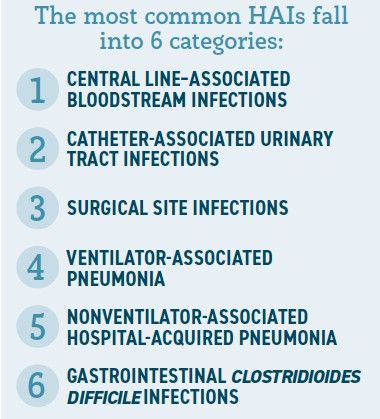
Although nosocomial infections are a serious concern in health care, more urgent threats exist. HAIs have been linked to antimicrobial-resistant and multidrug-resistantorganism (MDRO) infections, which are unaffected by 1 or more antibiotic, earning the moniker superbugs.9 The 5 superbugs that contribute to most HAIs are: methicillin-resistant Staphylococcus aureus (MRSA), vancomycin-resistant Enterococcus, carbapenem-resistant Enterobacterales, Acinetobacter baumannii, and Candida auris (C auris). Long-term care settings are particularly vulnerable to HAIs and MDROs, namely C difficile and C auris.10
It is important to understand the basic pathogen characteristics that enable them to survive and spread. For example, C difficile forms spores that persist on floors and surfaces and are difficult to destroy,11 whereas C auris colonizes skin and can pass from person to person or shed onto surfaces. MRSA and C auris often survive in protective biofilms, making them harder to eradicate.12
Transmission Ecosystem
Understanding the transmission ecosystem is the next step toward mitigating HAIs. It is a complex mix that involves infectious agents, patient susceptibility, and infection control practices. The source of the infectious agent is the first link in the chain of infection. Hence, the key to breaking the chain (Figure 1) is to address the source and disrupt its transmission.13
Figure 1. The chain of infection model
Source: Infectioncontrol.tips
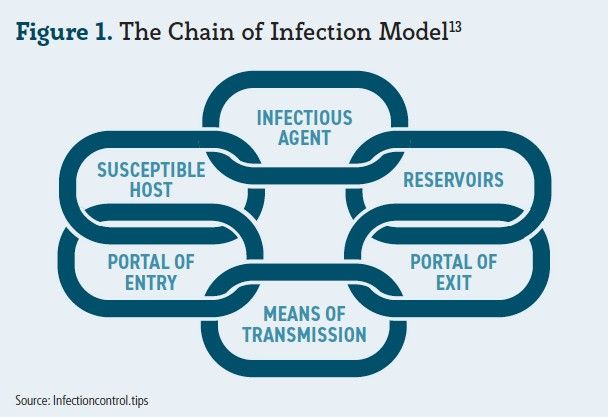
The 3 primary modes of HAI transmission are aerosol (airborne), droplets, and contact.14 However, some pathogens are transferred by more than 1 route. Although the pandemic targeted mitigation efforts on aerosol transmission, it diverted attention from other modes, which likely contributed to increases in HAIs.
According to the Centers for Disease Control and Prevention (CDC), environmental contamination is one of the highest-risk routes for transmission of the most prevalent nosocomial infections.15 Microbiologically contaminated surfaces (fomites) serve as reservoirs16 that allow pathogens to survive for hours, weeks, or even months.12 Transmission via fomites begins when inanimate objects are contaminated by an individual, droplets, or, in the case of C auris, shed skin that lands on surfaces.17 Indirect transmission occurs primarily through hand contact with fomites. Microbes are then transmitted to a person who can become infected and transfer to another person.18 This scenario illustrates a complex chain of infection, connecting the infectious source to the patient.
Figure 2. Reduce risk from surfaces: A key component of environmental cleaning
Source: Centers for Disease Control and Prevention
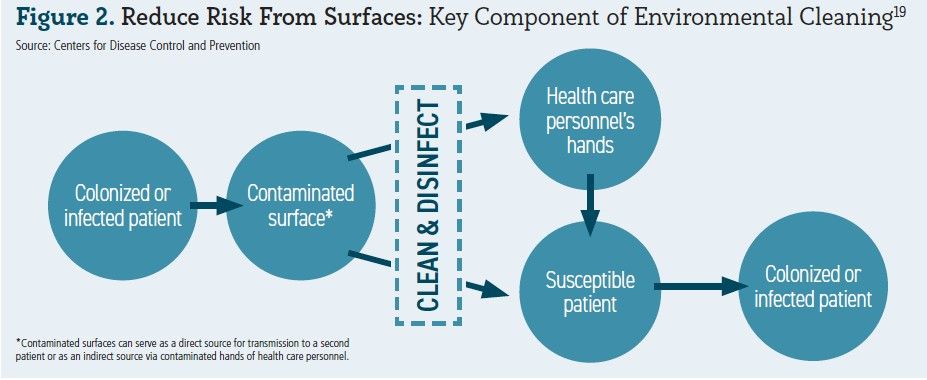
Studies have established that cross-transmission in the hospital environment is primarily because of contaminated surfaces (Figure 2) and the hands of health care workers.19 Research found that between 23% and 100% of the noncritical medical items were contaminated, up to 80% of them with pathogenic organisms and up to 25% with MDROs.20 Another study showed gloves did not prevent contamination or stop the spread of infections21 yet, approximately 30% of HAIs have been attributed to the contaminated hands of health care personnel.1
In the past, hospital floors were not viewed as high-risk surfaces, but that has begun to shift. Floors are a primary transmission route for C diff, 22 and C auris can be picked up on shoes and carried throughout a facility.17
Disrupting the Chain
Understanding pathogenic transmission modes is crucial to disrupting the chain of transmission, not only for specific diseases but also for other pathogens that follow a similar route.Reducing environmental risks for HAIs depends on implementing protective barriers along the path of transmission between microorganisms, the environment, and individuals.11
The CDC identified 17 high-touch surfaces with frequent hand contact that must be addressed when conducting daily and terminal cleanings in patient rooms.23 Unfortunately, studies have shown that less than 50% are effectively cleaned and disinfected with a sporicidal.24 Best practices for minimizing infection risk include cleaning and disinfection of allpatient care areas (Figure 3), as well as floors and all noncritical medical items used across the continuum of care.12
Figure 3. Example of high-touch surfaces in a specialized patient area12
Source: Centers for Disease Control and Prevention, National Center for Emerging and Zoonotic Infectious Diseases, Division of Healthcare Quality Promotion.
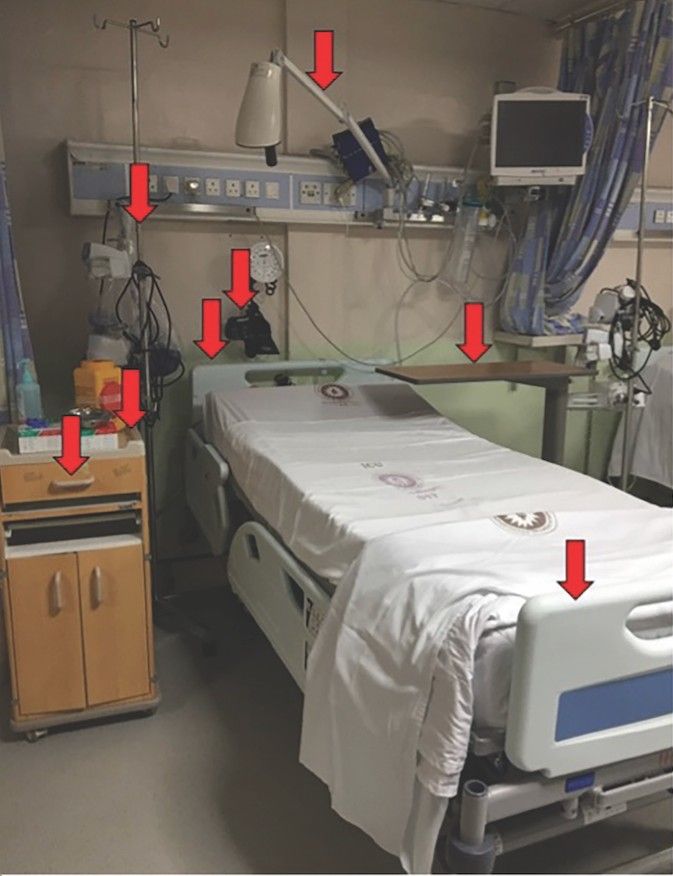
A foremost consideration in infection prevention and control (IPC) programs is choosing a disinfectant with ideal properties.25 Customary cleaning products widely used for hospital disinfection do not always address the most urgent threats, and those that do often have hazardous adverse effects. For example, quaternary ammonium compounds are not effective against C auris17 and, although sodium hypochlorite (bleach) and peracetic acid (PAA) have C auris claims,12 any efficacy is offset by associated health hazards. Alternatively, hydrogen peroxide may be less toxic and work on C auris,17 but it does not have a C diff claim. Moreover, of the aforementioned chemistries, only PAA has a biofilm claim but is an extremely hazardous chemical. The optimal approach is to utilize a broad-spectrum disinfectant with claims against all urgent threats and biofilm, as well as an ideal safety profile.
Another important consideration is preventing incidence of cross-contamination, particularly when working within time constraints. Terminal cleans can be executed more efficiently and effectively with touchless electrostatic sprayer technologies and, when combined with disposable wipes, more thorough disinfection can be achieved without recontamination.
Nonetheless, disinfection interventions on environmental surfaces are only 1 component in a larger system of IPC strategies. It is critically important that health care facilities take a system-level approach to reducing HAIs.25
Holistic Intervention
Mitigating HAIs requires a holistic approach to infection prevention that encompasses knowledge of all links in the chain of infection and layered interventions. Sustainability of interventions and program compliance are reliant on multimodal strategies that incorporate monitoring/auditing and prioritize ongoing education of current and incoming staff.25
Standardization has also become vital to the reduction of HAIs. Standardizing cleaning products and protocols simplifies processes, raises compliance, and creates universally effective IPC measures.
Reducing HAIs is everyone’s responsibility. All interprofessional health care team members have a stake in the process. Gaps in environmental control can be identified by anyone, from infection prevention and facility management to housekeeping. Incorporating multidisciplinary risk assessments, education, and compliance monitoring will allow for 360° surveillance and a greater ability to disrupt transmission of HAIs.
References:
1 Statistics on HAIs. Healthcare Surfaces Institute. https://www.healthcaresurfacesinstitute.org/statistics-on-hais/
2 McCaughey B. Unnecessary deaths: the human and financial costs of hospital infections. 3rd Edition. Committee to Reduce Infection Deaths (RID). https://www.hospitalinfection.org/ridbooklet.pdf
3 Hospital Infection Reporting. Committee to Reduce Infection Deaths (RID). https://hospitalinfection.org/resources/state-infection-laws/state-law-summary/
4 Record number of hospitals receive an ‘A,’ ‘B,’ ‘C,’ ‘D,’ or ‘F’ on the Leapfrog Hospital Safety Grade. Hospitalsafetygrade.org. November 10, 2021. https://www.hospitalsafetygrade.org/about-our-movement/newsroom/display/1020887
5 Health care-associated infections fact sheet. World Health Organization. https://www.who.int/gpsc/country_work/gpsc_ccisc_fact_sheet_en.pdf
6 Weiner-Lastinger L, Pattabiraman V, Konnor R, et al. The impact of coronavirus (COVID-19) on healthcare-associated infections in 2020: a summary of data reported to the National Healthcare Safety Network. Cambridge University Press. September 3, 2021. https://www.cambridge.org/core/journals/infection-control-and-hospital-epidemiology/article/impact-of-coronavirus-disease-2019-covid19-on-healthcareassociated-infections-in-2020-a-summary-of-data-reported-to-the-national-healthcare-safety-network/8197F323F4840D233A0C62F4726287E1#
7 Abdullah M. 5 most common hospital acquired infections (HAIs). Inivos, January 28, 2021.https://inivos.com/blog/5-most-common-hospital-acquired-infections-hais/
8 Monegro A, Muppidi V, Regunath H. Hospital acquired infections. StatPearls Publishing. August 30, 2021. https://www.ncbi.nlm.nih.gov/books/NBK441857/
9 Preventing healthcare associated infection (HAI). Victoria State Government Department of Health. https://www.betterhealth.vic.gov.au/health/conditionsandtreatments/infections-in-hospital-reduce-the-risk#types-of-healthcare-associated-infection
10 Dyer J. IP strategies for mitigating spread of candida auris. Infection Control Today. October 27, 2021. https://www.infectioncontroltoday.com/view/strategies-for-mitigating-spread-of-candida-auris
11 Curless M, Forrester L, Trexler P. Reference manual for health care facilities with limited resources: Infection prevention and control. Module 1. Introduction to infection prevention and control. Jhpiego, Johns Hopkins University Affiliate. May 20, 2020. https://www.c19hub.io/module-1-introduction-to-infection-prevention-and-control/
12 Homan L. The critical role of environmental hygiene in the prevention and control of candida auris. Healthcare Hygiene Magazine. September 2021. https://viewer.joomag.com/healthcare-hygiene-magazine-september-2021-september-2021/0280572001631046038?page=48
13 Higgins E, Connors B. The need to understand infection risk sources and pathways to mitigate HAIs. Patient Safety & Quality Healthcare (PSQH). November 12, 2020. https://www.psqh.com/analysis/the-need-to-understand-infection-risk-sources-and-pathways-to-mitigate-hais/
14 Clinical educators guide for the prevention and control of infection in healthcare. Australian Commission on Safety and Quality in Healthcare, National Health and Medical Research Council. https://www.nhmrc.gov.au/sites/default/files/documents/attachments/publications/icg-clinical-ed-guide.pdf
15 Healthcare-associated infections (HAIs) introduction: Best practices for environmental cleaning in healthcare facilities: in RLS. Centers for Disease Control and Prevention. April 22, 2022, https://www.cdc.gov/hai/prevent/resource-limited/introduction.html
16 Infection prevention and control (IPC) for COVID-29. National Centre for Disease Control India. April 3, 2020. https://ncdc.gov.in/WriteReadData/l892s/53436598731586345131.pdf
17 McCaughey B. RID guidelines for reducing the risk of candida auris. Committee to Reduce Infectious Deaths (RID). https://hospitalinfection.org/about/candida-auris/
18 Surfaces & HAIs FAQ. Healthcare Surfaces Institute. https://www.healthcaresurfacesinstitute.org/surfaces-and-hais-faq/
19 Doll M, Bearman G. Guide to infection control in the healthcare setting-New technologies in infection prevention. International Society for Infectious Diseases. January 2018. https://isid.org/wp-content/uploads/2019/06/ISID_GUIDE_NEW_TECHNOLOGIES_INFECTION_PREVENTION.pdf
20 Johnson L, Nutt A, Piatek D, et al. Strategies to mitigate cross contamination of non-critical medical devices. Association for Professionals in Infection Control and Epidemiology. https://apic.org/noncritical-is-critical/#:~:text=Rutala%20and%20Weber6%20have,in%20environmental%20services%2C%20patient%20equipment%2C
21 Preventing healthcare associated infection (HAI). Victoria State Government Department of Health. https://www.betterhealth.vic.gov.au/health/conditionsandtreatments/infections-in-hospital-reduce-the-risk#types-of-healthcare-associated-infection
22 Teska P, Gauthier J. Floor hygiene and the under-studied risk of pathogen dissemination. GBAC, TIPS. Infectioncontrol.tips. June 9, 2021. https://infectioncontrol.tips/2021/06/09/floor-hygiene-and-the-under-studied-risk-of-pathogen-dissemination/
23 Environmental checklist for monitoring terminal cleaning. Centers for Disease Control and Prevention. https://www.cdc.gov/hai/pdfs/toolkits/environmental-cleaning-checklist-10-6-2010.pdf
24 Rea D, Healthcare Associated Infections & the Environment: Mitigating Risk with Environmental Control Strategies, Healthcare Facilities Today, June 18, 2018, https://www.healthcarefacilitiestoday.com/posts/Healthcare-associated-infections-the-environment-Mitigating-risk-with-environmental-control-strategies--18670
25 Christenson E, Cronk R, Atkinson H, et al. Evidence map and systematic review of disinfection efficacy on environmental surfaces in healthcare facilities. International Journal of Environmental Research and Public Health (IJERP). October 22, 2021. https://pubmed.ncbi.nlm.nih.gov/34769620/
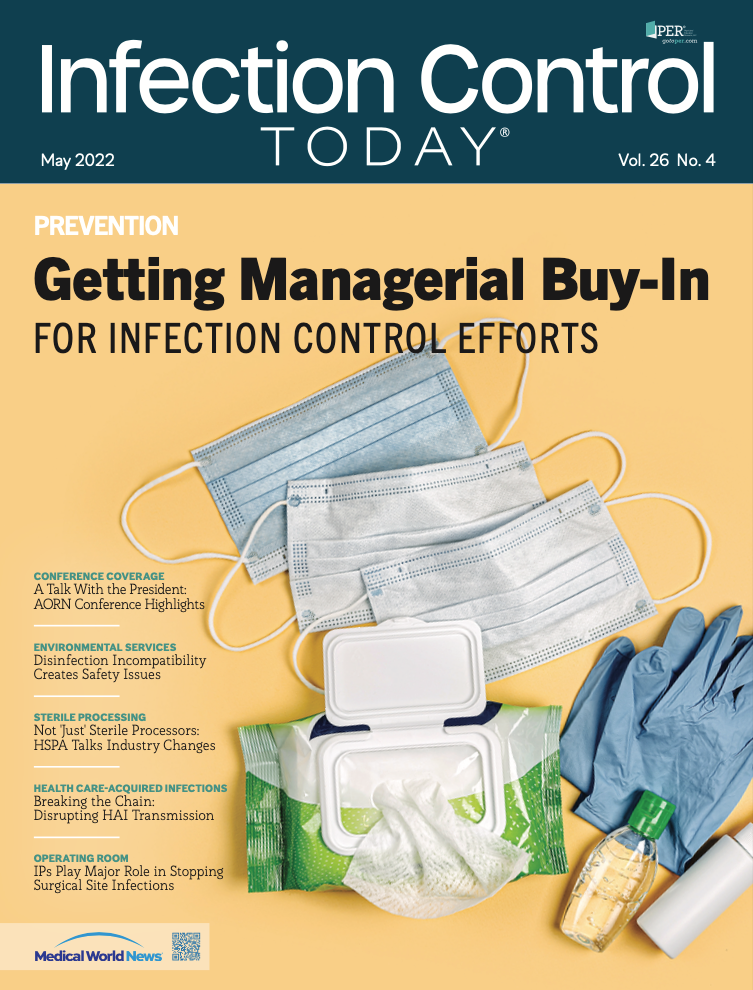
Robust infectious disease surveillance, including rapid subtyping of influenza A, is essential for early detection, containment, and public health reporting of novel viral threats.